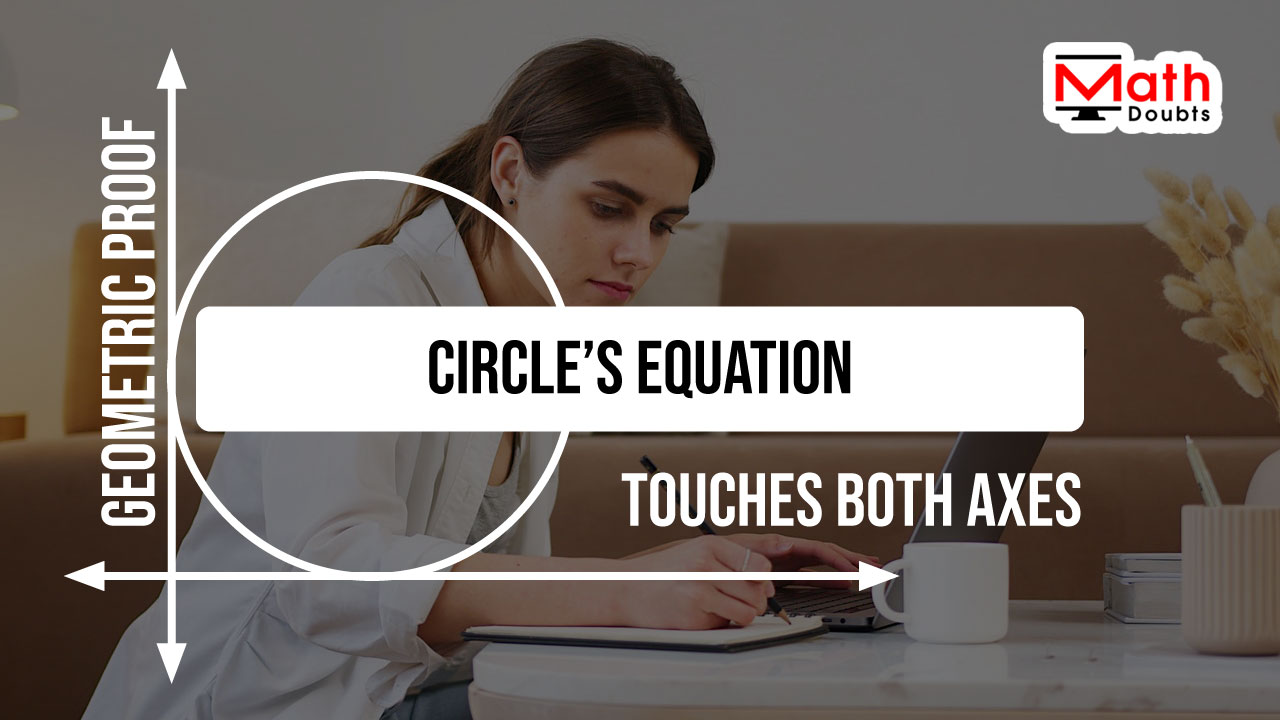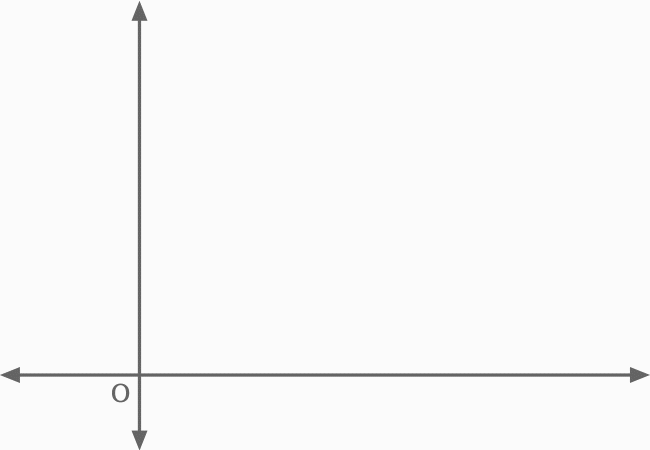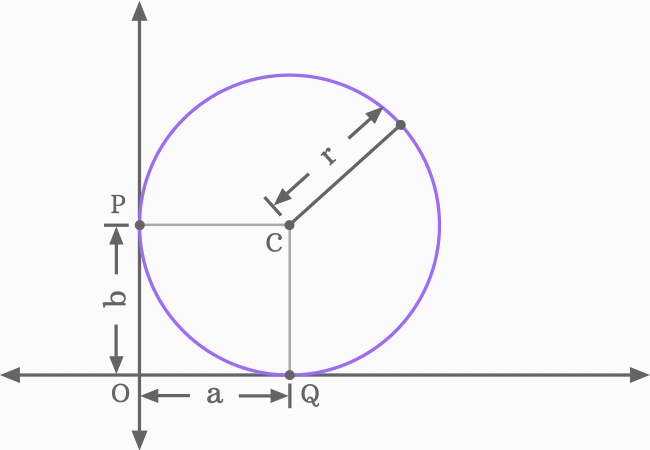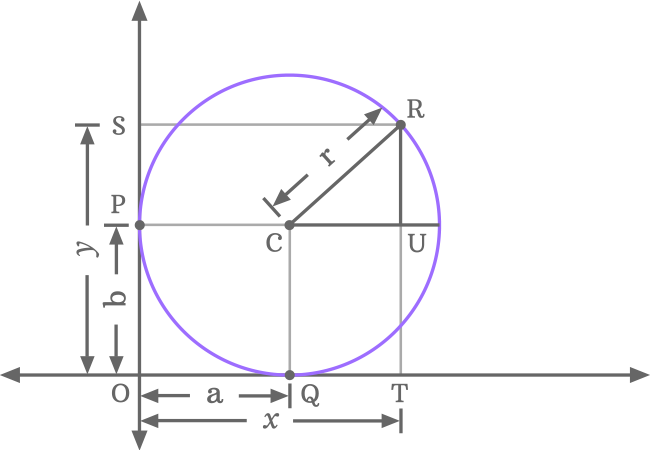
The equation of a circle touches both axes, is written in the following three forms in mathematics.
$(1).\,\,$ $(x-a)^2+(y-a)^2$ $\,=\,$ $a^2$
$(2).\,\,$ $(x-b)^2+(y-b)^2$ $\,=\,$ $b^2$
$(3).\,\,$ $(x-r)^2+(y-r)^2$ $\,=\,$ $r^2$
You can use represent the circle touching the both axes by any one of the above three equations. So, let us learn how prove the equation of a circle touches both axes of two dimensional cartesian coordinate system in mathematical form geometrically.
A right triangle must be constructed inside a circle when the circle is touching both $x$-axis and $y$-axis in a quadrant of the two dimensional cartesian coordinate system and it is useful to derive the mathematical equation of a circle, which touches both axes.

There are five geometrical steps to construct a right angled triangle inside a circle when the circle touches both $x$-axis and $y$-axis of the two dimensional space.
It is time to understand the geometrical relationship between the radius and the coordinates of the circle.

The distance from center to point $Q$ is the radius of the circle and it is exactly equal to the distance from origin to point $P$. Actually, it is the $y$-coordinate of the centre of the circle.
$\implies$ $CQ \,=\, OP$
$\,\,\,\therefore\,\,\,\,\,\,$ $r \,=\, b$
Similarly, the distance from point $P$ to centre is the radius of the circle and it is exactly equal to the distance from the origin to the point $Q$. In fact, it is the $x$-coordinate of the center of the circle.
$\implies$ $OQ \,=\, PC$
$\,\,\,\therefore\,\,\,\,\,\,$ $a \,=\, r$
The above two mathematical equations are cleared that the $x$-coordinate and $y$-coordinate are exactly equal to the radius of the circle.
$\,\,\,\therefore\,\,\,\,\,\,$ $a$ $\,=\,$ $b$ $\,=\,$ $r$
In $\Delta UCR$, the opposite side is $\overline{RU}$, the adjacent side is $\overline{CU}$ and the hypotenuse is $\overline{CR}$, and their lengths are written as $RU, CU$ and $CR$ respectively.

Now, let us find the length of every side of the right angled triangle mathematically.
According to the Pythagorean Theorem, the lengths of all three sides of right triangle $UCR$ can be written mathematically in an equation.
${CR}^2$ $\,=\,$ ${CU}^2+{RU}^2$

In this equation, $CU, CR$ and $RU$ represent the lengths of adjacent side, hypotenuse and opposite side. Now, substitute their values in the above mathematical equation.
$\implies$ $r^2$ $\,=\,$ $(x-a)^2+(y-b)^2$
$\,\,\,\therefore\,\,\,\,\,\,$ $(x-a)^2+(y-b)^2$ $\,=\,$ $r^2$
It is a mathematical equation of a circle when the $C(a, b)$ is the center (or centre) and the radius of the circle is $r$ units. It is actually a standard equation of a circle.
We have derived that $a$ $\,=\,$ $b$ $\,=\,$ $r$, when the circle is touching the both axes. Now, the standard equation of a circle can be converted as an equation that represents a circle touches the both horizontal and vertical axes by this condition. Therefore, the equation of a circle touching both axes can be written in any one of the following forms in mathematics.
$(1).\,\,$ $(x-a)^2+(y-a)^2$ $\,=\,$ $a^2$ when $b$ and $r$ are replaced by $a$
$(2).\,\,$ $(x-b)^2+(y-b)^2$ $\,=\,$ $b^2$ when $a$ and $r$ are replaced by $b$
$(3).\,\,$ $(x-r)^2+(y-r)^2$ $\,=\,$ $r^2$ when $a$ and $b$ are replaced by $r$
Take any one of the about three equations to express it in expansion form.
$(x-a)^2+(y-a)^2$ $\,=\,$ $a^2$
Now, expand each term on the left hand side of the equation as per the square of difference formula.
$\implies$ $x^2$ $+$ $a^2$ $-$ $2ax$ $+$ $y^2$ $+$ $a^2$ $-$ $2ay$ $\,=\,$ $a^2$
$\implies$ $x^2$ $+$ $y^2$ $-$ $2ax$ $-$ $2ay$ $+$ $a^2$ $+$ $a^2$ $\,=\,$ $a^2$
$\implies$ $x^2$ $+$ $y^2$ $-$ $2ax$ $-$ $2ay$ $+$ $a^2$ $+$ $a^2$ $-$ $a^2$ $\,=\,$ $0$
$\implies$ $x^2$ $+$ $y^2$ $-$ $2ax$ $-$ $2ay$ $+$ $a^2$ $+$ $\cancel{a^2}$ $-$ $\cancel{a^2}$ $\,=\,$ $0$
$\implies$ $x^2$ $+$ $y^2$ $-$ $2ax$ $-$ $2ay$ $+$ $a^2$ $\,=\,$ $0$
$\,\,\,\therefore\,\,\,\,\,\,$ $x^2$ $+$ $y^2$ $-$ $2a(x+y)$ $+$ $a^2$ $\,=\,$ $0$
It is an expansion of the equation of a circle when the circle is touching the both axes. Therefore, the above three forms can be written in expansion form as follows.
$(1).\,\,$ $x^2$ $+$ $y^2$ $-$ $2a(x+y)$ $+$ $a^2$ $\,=\,$ $0$
$(2).\,\,$ $x^2$ $+$ $y^2$ $-$ $2b(x+y)$ $+$ $b^2$ $\,=\,$ $0$
$(3).\,\,$ $x^2$ $+$ $y^2$ $-$ $2r(x+y)$ $+$ $r^2$ $\,=\,$ $0$
We have taken $C(a, b)$ is the center of a circle in coordinate form. In some countries, the centre of a circle in coordinate form is taken as $C(h, k)$, then the equation of a circle touches both axes is written as follows.
$(1).\,\,$ $(x-h)^2+(y-h)^2$ $\,=\,$ $h^2$
$(2).\,\,$ $(x-k)^2+(y-k)^2$ $\,=\,$ $k^2$
$(3).\,\,$ $(x-r)^2+(y-r)^2$ $\,=\,$ $r^2$
The above equations are expanded respectively in the following forms.
$(1).\,\,$ $x^2$ $+$ $y^2$ $-$ $2h(x+y)$ $+$ $h^2$ $\,=\,$ $0$
$(2).\,\,$ $x^2$ $+$ $y^2$ $-$ $2k(x+y)$ $+$ $k^2$ $\,=\,$ $0$
$(3).\,\,$ $x^2$ $+$ $y^2$ $-$ $2r(x+y)$ $+$ $r^2$ $\,=\,$ $0$
A free math education service for students to learn every math concept easily, for teachers to teach mathematics understandably and for mathematicians to share their maths researching projects.
Copyright © 2012 - 2023 Math Doubts, All Rights Reserved